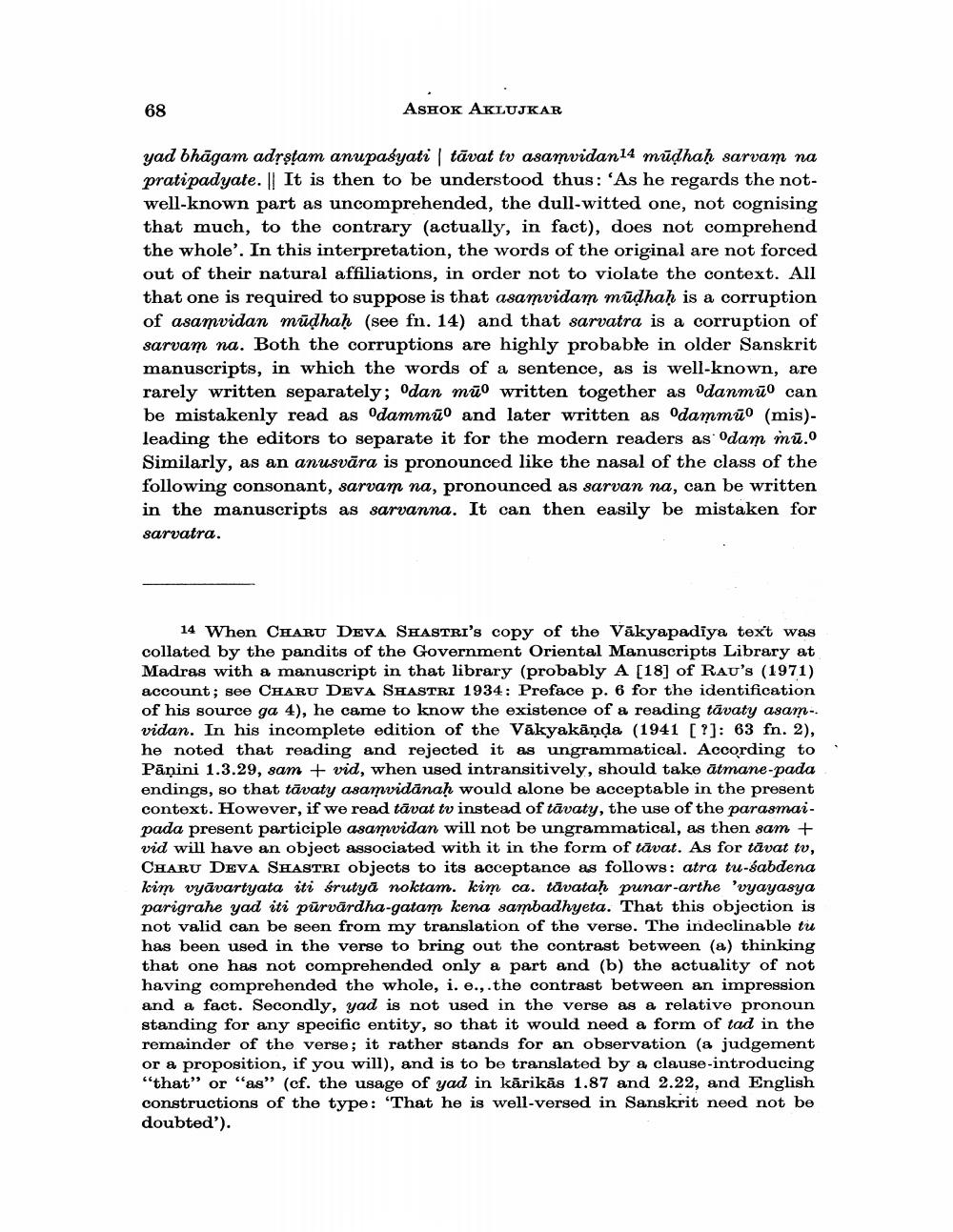Book Title: Emendation Of Some Verses In Bhrtharis Trikandi Author(s): Ashok Aklujkar Publisher: Ashok Aklujkar View full book textPage 6
________________ 68 ASHOK AKLUJKAR yad bhāgam adrstam anupaśyati | tāvat tv asamvidan 14 mūdhaḥ sarvam na prati padyate. || It is then to be understood thus: 'As he regards the notwell-known part as uncomprehended, the dull-witted one, not cognising that much, to the contrary (actually, in fact), does not comprehend the whole'. In this interpretation, the words of the original are not forced out of their natural affiliations, in order not to violate the context. All that one is required to suppose is that asamvidam mudhah is a corruption of asamvidan müdhaḥ (see fn. 14) and that sarvatra is a corruption of sarvam na. Both the corruptions are highly probable in older Sanskrit manuscripts, in which the words of a sentence, as is well-known, are rarely written separately; "dan mū0 written together as 'danmūO can be mistakenly read as "dammūo and later written as dammu (mis). leading the editors to separate it for the modern readers as Odam mū. Similarly, as an anusvāra is pronounced like the nasal of the class of the following consonant, sarvam na, pronounced as sarvan na, can be written in the manuscripts as sarvanna. It can then easily be mistaken for sarvatra. 14 When CHARU DEVA SHASTRI's copy of the Vākyapadiya text was collated by the pandits of the Government Oriental Manuscripts Library at Madras with a manuscript in that library (probably A [18] of Rau's (1971) account; see CHARU DEVA SHASTRI 1934: Preface p. 6 for the identification of his source ga 4), he came to know the existence of a reading tävaty asam.. vidan. In his incomplete edition of the Vakyakända (1941 [?]: 63 fn. 2). he noted that reading and rejected it as ungrammatical. According to Pānini 1.3.29, sam + vid, when used intransitively, should take ätmane-pada endings, so that tāvaty asamvidānah would alone be acceptable in the present context. However, if we read tāvat tv instead of tāvaty, the use of the parasmaipada present participle asamvidan will not be ungrammatical, as then sam + vid will have an object associated with it in the form of tāvat. As for tävat tv, CHARU DEVA SHASTRI objects to its acceptance as follows: atra tu-sabdena kim vyāvartyata iti śrutyà noktam. kim ca. tavataḥ punar-arthe 'vyayasya parigrahe yad iti pūrvärdha-gatam kena sambadhyeta. That this objection is not valid can be seen from my translation of the verse. The indeclinable tu has been used in the verse to bring out the contrast between (a) thinking that one has not comprehended only a part and (b) the actuality of not having comprehended the whole, i. e...the contrast between an impression and a fact. Secondly, yad is not used in the verse as a relative pronoun standing for any specific entity, so that it would need a form of tad in the remainder of the verse; it rather stands for an observation (a judgement or a proposition, if you will), and is to be translated by a clause-introducing “that" or "as" (cf. the usage of yad in kārikās 1.87 and 2.22, and English constructions of the type: "That he is well-versed in Sanskrit need not be doubted').Page Navigation
1 ... 4 5 6 7 8 9 10 11 12
